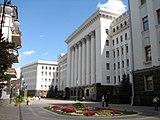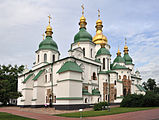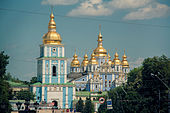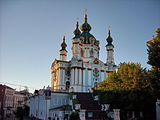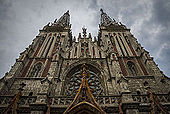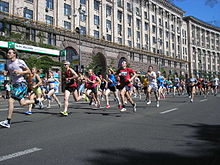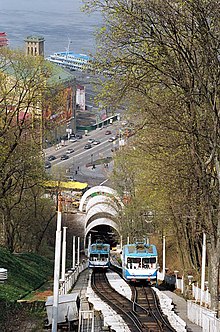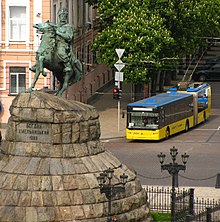Kiev (/ˈkiːɛf, -ɛv/)[7] or Kyiv (Ukrainian: Київ [ˈkɪjiu̯]; Russian: Киев [ˈkʲiɪf]) is the capital and largest city of Ukraine, located in the north central part of the country on the Dnieper River. The population in July 2013 was 2,847,200[1](though higher estimated numbers have been cited in the press),[8] making Kiev the 8th most populous city in Europe.
Kiev is an important industrial, scientific, educational, and cultural centre of Eastern Europe. It is home to many high-tech industries, higher education institutions and world-famous historical landmarks. The city has an extensive infrastructure and highly developed system of public transport, including the Kiev Metro.
Environment
Geography

Geographically, Kiev belongs to the Polesia ecological zone (a part of the European mixed woods). However, the city's unique landscape distinguishes it from the surrounding region.
Kiev is located on both sides of the Dnieper River, which flows south through the city towards the Black Sea. The older right-bank (western) part of the city is represented by numerous woody hills, ravines and small rivers. It is a part of the larger Dnieper Upland adjoining the western bank of the Dnieper in its mid-flow. Kiev expanded to the Dnieper's lowland left bank (to the east) only in the 20th century. Significant areas of the left-bank Dnieper valley were artificially sand-deposited, and are protected by dams.
The Dnieper River forms a branching system of tributaries, isles, and harbors within the city limits. The city is adjoined by the mouth of the Desna River and the Kiev Reservoir in the north, and the Kaniv Reservoir in the south. Both the Dnieper and Desna rivers are navigable at Kiev, although regulated by the reservoir shipping locks and limited by winter freeze-over.
In total, there are 448 bodies of open water within the boundaries of Kiev, which include Dnieper itself, its reservoirs, and several small rivers, dozens of lakes and artificially created ponds. They occupy 7949 hectares of territory. Additionally, the city boasts of 16 developed beaches (totalling 140 hectares) and 35 near-water recreational areas (covering more than 1000 hectares). Many are used for pleasure and recreation, although some of the bodies of water are not suitable for swimming.[52]
According to the UN 2011 evaluation, there were no risks of natural disasters in Kiev and its metropolitan area[53]
Climate
Kiev has a humid continental climate (Köppen Dfb).[54] The warmest months are June, July, and August, with mean temperatures of 13.8 to 24.8 °C (56.8 to 76.6 °F). The coldest are December, January, and February, with mean temperatures of −4.6 to −1.1 °C (23.7 to 30.0 °F). The highest ever temperature recorded in the city was 39.4 °C (102.9 °F) on 31 July 1936. The coldest temperature ever recorded in the city was −32.2 °C (−26.0 °F) on 7 and 9 February 1929. Snow cover usually lies from mid-November to the end of March, with the frost-free period lasting 180 days on average, but surpassing 200 days in recent years.[55]
Legal status, local government and politics
Legal status and local government
The municipality of the city of Kiev has a special legal status within Ukraine compared to the other administrative subdivisions of the country. The most significant difference is that the city is considered as a region of Ukraine (see Regions of Ukraine). It is the only city that has double jurisdiction. The Head of City State Administration — the city's governor, is appointed by thePresident of Ukraine, while the Head of the City Council — the Mayor of Kiev, is elected by a local popular vote.
The current Mayor of Kiev is Vitali Klitschko who was sworn in on 5 June 2014;[3] after he had won the 25 May 2014 Kiev mayoral elections with almost 57% of the votes.[58] Since 25 June 2014 Klitschko is also Head of Kiev City Administration.[4]
Most important buildings of the national government (Cabinet of Ukraine, Verkhovna Rada, others) are located along vulytsia Mykhaila Hrushevskoho (Mykhailo Hrushevsky Street) and vulytsia Instytutska (Institute Street). Hrushevskoho Street is named after the Ukrainian academician, politician, historian, and statesman Mykhailo Hrushevskyi, who wrote an academic book titled: "Bar Starostvo: Historical Notes: XV-XVIII" about the history of Bar, Ukraine.[59] That portion of the city is also unofficially known as the government quarter (Ukrainian: урядовий квартал). The city also has a great number of buildings for various embassies, ministerial and other important buildings.
The city state administration and council is located in the Kiev City's council building on Khreshchatyk Street. The oblast state administration and council is located in the Kiev Oblast council building on ploshcha Lesi Ukrayinky (Lesya Ukrayinka Square). The Kiev-Sviatoshyn Raion state administration is located near Kiltseva doroha (Ring Road) on prospekt Peremohy (Victory Parkway), while the Kiev-Svyatoshyn Raion local council is located on vulytsia Yantarna (Yantarnaya Street).
Cityscape
Modern Kiev is a mix of the old (Kiev preserved about 70 percent of more than 1,000 buildings built during 1907–1914[71]) and the new, seen in everything from the architecture to the stores and to the people themselves. When the capital of theUkrainian SSR was moved from Kharkiv to Kiev many new buildings were commissioned to give the city "the gloss and polish of a capital".[71] In the discussions centered on how to create a showcase city center the current city center of Khreshchatykand Maidan Nezalezhnosti (Independence Square) were not the obvious choices.[71] Some of the early, ultimately not materialised, ideas included a part of Pechersk, Lypky, European Square and Mykhailivska Square.[71] The plans of building massive monuments (of Vladimir Lenin and Joseph Stalin) were also abandoned; due to lack of money (in the 1930s–1950s) and because of Kiev's hilly landscape.[71] Experiencing rapid population growth between the 1970s and the mid-1990s, the city has continued its consistent growth after the turn of the millennium. As a result, Kiev's central districts provide a dotted contrast of new, modern buildings among the pale yellows, blues and greys of older apartments. Urban sprawl has gradually reduced, while population densities of suburbs has increased. The most expensive properties are located in the Pechersk, and Khreshchatyk areas. It is also prestigious to own a property in newly constructed buildings in the Kharkivskyi Raion orObolon along the Dnieper.

Ukrainian independence at the turn of the millennium has heralded other changes. Western-style residential complexes, modern nightclubs, classy restaurants and prestigious hotels opened in the centre. And most importantly, with the easing of the visa rules in 2005,[72] Ukraine is positioning itself as a prime tourist attraction, with Kiev, among the other large cities, looking to profit from new opportunities. The centre of Kiev has been cleaned up and buildings have been restored and redecorated, especially Khreshchatyk and Maidan Nezalezhnosti. Many historic areas of Kiev, such as Andriyivskyy Descent, have become popular street vendor locations, where one can find traditional Ukrainian art, religious items, books, game sets (most commonly chess) as well as jewellery for sale.[73]
At the United Nations Climate Change Conference 2009 Kiev was the only Commonwealth of Independent States city to have been inscribed into the TOP30 European Green City Index (placed 30th).[74]
Kiev's most famous historical architecture complexes are the St. Sophia Cathedral and the Kiev Pechersk Lavra (Monastery of the Caves), which are recognized by UNESCO as a World Heritage Site. Noteworthy historical architectural landmarks also include the Mariyinsky Palace (designed and constructed from 1745 to 1752, then reconstructed in 1870), several Orthodox churches such as St. Michael's Cathedral, St. Andrew's, St. Vladimir's, the reconstructed Golden Gate and others.
One of Kiev's widely recognized modern landmarks is the highly visible giant Mother Motherland statue made of titanium standing at the Museum of The History of Ukraine in World War II on the Right bank of the Dnieper River. Other notable sites is the cylindrical Salut hotel, located across from Glory Square and the eternal flame at the World War Two memorial Tomb of the Unknown Soldier, and the House with Chimaeras.
Among Kiev's best-known monuments are Mikhail Mikeshin's statue of Bohdan Khmelnytsky astride his horse located near St. Sophia Cathedral, the venerated Vladimir the Great (St. Vladimir), the baptizer of Rus', overlooking the river above Podil fromVolodymyrska Hill, the monument to Kyi, Schek and Khoryv and Lybid, the legendary founders of the city located at the Dnieper embankment. On Independence Square in the city centre, two monuments elevate two of the city protectors; the historic protector of Kiev Michael Archangel atop a reconstruction of one of the old city's gates and a modern invention, the goddess-protector Berehynia atop a tall column.
Attractions
It is said that one can walk from one end of Kiev to the other in the summertime without leaving the shade of its many trees. Most characteristic are the horse-chestnuts (Ukrainian: каштани, kashtany).
Kiev is known as a green city with two botanical gardens and numerous large and small parks. The Museum of The History of Ukraine in World War II is located here, which offers both indoor and outdoor displays of military history and equipment surrounded by verdant hills overlooking the Dnieper river.
Among the numerous islands, Venetsianskyi (or Hydropark) is the most developed. It is accessible by metro or by car, and includes an amusement park, swimming beaches, boat rentals, and night clubs. The Victory Park (Park Peremohy) located near Darnytsia subway station is a popular destination for strollers, joggers, and cyclists. Boating, fishing, and water sports are popular pastimes in Kiev. The area lakes and rivers freeze over in the winter and ice fishermen are a frequent sight, as are children with their ice skates. However, the peak of summer draws out a greater mass of people to the shores for swimming or sunbathing, with daytime high temperatures sometimes reaching 30 to 34 °C (86 to 93 °F).[citation needed]
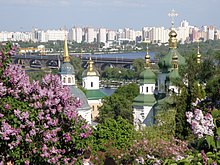
The centre of Kiev (Independence Squareand Khreschatyk Street) becomes a large outdoor party place at night during summer months, with thousands of people having a good time in nearby restaurants, clubs and outdoor cafes. The central streets are closed for auto traffic on weekends and holidays. Andriyivskyy Descent is one of the best known historic streets and a major tourist attraction in Kiev. The hill is the site of the Castle of Richard the Lionheart; the baroque-style St Andrew's Church; the home of Kiev born writer, Mikhail Bulgakov; the monument to Yaroslav the Wise, the Grand Prince of Kiev and of Novgorod; and numerous other monuments.[76][77]
A wide variety of farm produce is available in many of Kiev's farmer markets with the Besarabsky Market located in the very centre of the city being most famous. Each residential region has its own market, or rynok. Here one will find table after table of individuals hawking everything imaginable: vegetables, fresh and smoked meats, fish, cheese, honey, dairy products such as milk and home-made smetana (sour cream), caviar, cut flowers, housewares, tools and hardware, and clothing. Each of the markets has its own unique mix of products with some markets devoted solely to specific wares such as automobiles, car parts, pets, clothing, flowers, and other things.
At the city's southern outskirts, near the historic Pyrohiv village, there is an outdoor museum, officially called the Museum of Folk Architecture and Life of Ukraine It has an area of 1.5 square kilometres (1 sq mi). This territory houses several "mini-villages" that represent by region the traditional rural architecture of Ukraine.
Kiev also has numerous recreational attractions like bowling alleys, go-cart tracks, paintball venues, billiard halls and even shooting ranges. The 100-year-old Kiev Zoo is located on 40 hectares and according to CBC "the zoo has 2,600 animals from 328 species".[78]
Museums and galleries
Kiev is home to some 40 different museums.[79] In 2009 they recorded a total of 4.3 million visits.[79]
The Museum of The History of Ukraine in World War II is a memorial complex commemorating the Eastern Front of World War II located in the hills on the right-bank of the Dnieper River in Pechersk. Kiev fortress is the 19th-century fortification buildings situated in Ukrainian capital Kiev, that once belonged to western Russian fortresses. These structures (once a united complex) were built in the Pechersk and neighbourhoods by theRussian army. Now some of the buildings are restored and turned into a museum called theKiev Fortress, while others are in use in various military and commercial installations. The National Art Museum of Ukraineis a museum dedicated to Ukrainian art. The Golden Gate is a historic gateway in the ancient city's walls. The name Zoloti Vorota is also used for a nearby theatre and a station of the Kiev Metro. The small Ukrainian National Chernobyl Museumacts as both a memorial and historical center devoted to the events surrounding the 1986 Chernobyl disaster and its effect on the Ukrainian people, the environment, and subsequent attitudes toward the safety of nuclear power as a whole.
Sports
Kiev has many professional and amateur football clubs, including Dynamo Kyiv, Arsenal Kyiv and FC Obolon Kyiv which play in the Ukrainian Premier League. Of these three, Dynamo Kyiv has had the most success over the course of its history. For example, up until the collapse of the Soviet Union in 1991, the club won 13 USSR Championships, 9 USSR Cups, and 3 USSR Super Cups, thus making Dynamo the most successful club in the history of the Soviet Top League.[80]
Other prominent non-football sport clubs in the city include: the Sokil Kiev ice hockey club and BC Kyiv basketball club. Both of these teams play in the highest Ukrainian leagues for their respective sports and whilst BC Kyiv was founded just recently in 1999, Sokil was founded in 1963, during the existence of the Soviet Union. Both these teams play their home games at the Kiev Palace of Sports.
During the 1980 Summer Olympics held in the Soviet Union, Kiev held the preliminary matches and the quarter-finals of the football tournament at its Olympic Stadium, which was reconstructed specially for the event. From 1 December 2008 stadium the stadium underwent a full-scale reconstruction in order to satisfy standards put in place by UEFA for hosting the Euro 2012football tournament; the opening ceremony took place in the presence of president Viktor Yanukovich on 8 October 2011,[81]with the first major event being a Shakira concert which was specially planned to coincide with the stadium's re-opening during Euro 2012. Other notable sport stadiums/sport complexes in Kiev include the Lobanovsky Dynamo Stadium, thePalace of Sports, among many others.
Most Ukrainian national teams play their home international matches in Kiev. The Ukraine national football team, for example, will play matches at the re-constructed Olympic Stadium from 2011.
Tourism
Since introducing a visa-free regime for EU-member states and Switzerland in 2005, Ukraine has seen a steady increase in the number of foreign tourists visiting the country.[82] Prior to the 2008–2009 recession the average annual growth in the number of foreign visits in Kiev was 23% over a three-year period.[83] In 2009 a total of 1.6 million tourists stayed in Kiev hotels of which almost 259,000 (ca. 16%) were foreigners.[83]
Economy
See also: Category:Economy of Kiev, Economy of Ukraine
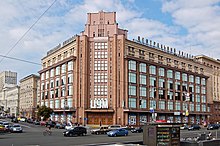
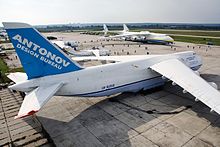
As with most capital cities, Kiev is a major administrative, cultural and scientific centre of the country. It is the largest city in Ukraine in terms of both population and area and enjoys the highest levels of business activity. On 1 January 2010 there were around 238,000 business entities registered in Kiev.[84]
Official figures show that between 2004 and 2008 Kiev's economy outstripped the rest of the country's, growing by an annual average of 11.5%.[85][86] Following the global financial crisis that began in 2007, Kiev's economy suffered a severe setback in 2009 with gross regional product contracting by 13.5% in real terms.[85] Although a record high, the decline in activity was 1.6 percentage points smaller than that for the country as a whole.[86] The economy in Kiev, as in the rest of Ukraine, recovered somewhat in 2010 and 2011. Kiev is a middle-income city, with prices currently comparable to many mid-size American cities (i.e., considerably lower than Western Europe).
Because the city boasts a large and diverse economic base and is not dependent on any single industry and/or company, its unemployment rate has historically been relatively low – only 3.75% over 2005–2008.[87] Indeed, even as the rate of joblessness jumped to 7.1% in 2009, it remained far below the national average of 9.6%.[87][88]
Kiev is the undisputed center of business and commerce of Ukraine and home to the country's largest companies, such asNaftogaz Ukrainy, Energorynok and Kyivstar. In 2010 the city accounted for 18% of national retail sales and 24% of all construction activity.[89][90][91][92] Indeed, real estate is one of the major forces in Kiev's economy. Average prices ofapartments are the highest in the country and among the highest in eastern Europe.[93] Kiev also ranks high in terms ofcommercial real estate for it is here where the country's tallest office buildings (such as Gulliver and Parus) and some of Ukraine's biggest shopping malls (such as Dream Town and Ocean Plaza) are located.
In May 2011 Kiev authorities presented a 15-year development strategy which calls for attracting as much as EUR82 billion of foreign investment by 2025 to modernize the city’s transport and utilities infrastructure and make it more attractive for tourists.[94]
* – data not available; ** – calculated at annual average official exchange rate; *** – ILO methodology (% of workforce).
Industry
Primary industries in Kiev include utilities – i.e., electricity, gas and water supply (26% of total industrial output), manufacture of food, beverages and tobacco products (22%), chemical (17%), mechanical engineering (13%) and manufacture of paper and paper products, including publishing, printing and reproduction of recorded media (11%).[99] The Institute of Oil Transportation is headquartered here.
Manufacture
- Leninska Kuznya, naval production
- Antonov Serial Production Plant (former Aviant), airplanes manufacturing
- Aeros, small aircraft production
- Kiev Roshen Factory, confectionery
- Kiev Arsenal (former arms manufacturer), specializes in production of optic-precision instruments
- Obolon, brewery
- Kiev Aircraft Repair Plant 410, repair factory located at Zhulyany Airport
Education and science
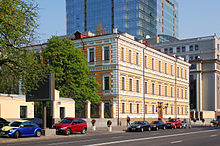
Scientific research
Scientific research is conducted in many institutes of higher education and, additionally, in many research institutes affiliated with the Ukrainian Academy of Sciences. Kiev is home to Ukraine's ministry of education and science, and is also noted for its contributions to medical and computer science research.
University education
Kiev hosts many universities, the major ones being Kiev National Taras Shevchenko University,[100] the National Technical University "Kiev Polytechnic Institute",[101] and the Kyiv-Mohyla Academy.[102] Of these, the Mohyla Academy is the oldest outright, having been founded as a theological school in 1632, however the Shevchenko University, which was founded in 1834, is the oldest in continuous operation. The total number of institutions of higher education in Kiev currently approaches 200,[103] allowing young people to pursue almost any line of study. While education traditionally remains largely in the hands of the state there are several accredited private institutions in the city.
Secondary education
There are about 530 general secondary schools and ca. 680 nursery schools and kindergartens in Kiev.[104] Additionally, there are evening schools for adults, and specialist technical schools.
Public libraries
There are many libraries in the city with the Vernadsky National Library, which is Ukraine's main academic library and scientific information centre, as well as one of the world's largest national libraries, being the largest and most important one.[105] The National Library is affiliated with the Academy of Sciences in so far as it is a deposit library and thus serves as the academy's archives' store. Interestingly the national library is the world’s foremost repository of Jewish folk music recorded on Edison wax cylinders. Their Collection of Jewish Musical Folklore (1912–1947) was inscribed on UNESCO's Memory of the World Register in 2005.[106]
Transportation
Local public transport

Local public transportation in Kiev includes the Metro (underground), buses and minibuses,trolleybuses, trams, taxi and funicular. There is also an intra-city ring railway service.
The publicly owned and operated Kiev Metro is the fastest, the most convenient and affordable network that covers most, but not all, of the city. The Metro is continuously expanding towards the city limits to meet growing demand, currently having three lines with a total length of 66.1 kilometres (41.1 miles) and 51 stations (some of which are renowned architectural landmarks). The Metro carries around 1.422 million passengers daily[107]accounting for 38% of the Kiev's public transport load. In 2011, the total number of trips exceeded 519 million.
The historic Kiev tram system was the first electric tramway in the former Russian Empire and the third one in Europe after the Berlin Straßenbahn and the Budapest tramway. The tram system currently consists of 139.9 km (86.9 mi) of track,[108] including 14 km (8.7 mi) two Rapid Tram lines, served by 21 routes with the use of 523 tram cars. Once a well maintained and widely used method of transport, the system is now gradually being phased out in favor of buses and trolleybuses.
The Kiev funicular was constructed during 1902–1905. It connects the historic Uppertown, and the lower commercial neighborhood of Podil through the steep Volodymyrska Hilloverseeing the Dnieper River. The line consists of only two stations.
All public road transport (except for some minibuses) is operated by the unitedKyivpastrans municipal company. It is heavily subsidized by the city.
The Kiev public transport system, except for taxi, uses a simple flat rate tariff system regardless of distance traveled: tickets or tokens must be purchased each time a vehicle is boarded. Digital ticket system is already established in Kiev Metro, with plans for other transport modes. Discount passes are available for grade school and higher education students. Pensioners use public transportation free. There are monthly passes in all combinations of public transportation. Ticket prices are regulated by the city government, and the cost of one ride is far lower than in Western Europe.
The taxi market in Kiev is expansive but not regulated. In particular, the taxi fare per kilometer is not regulated. There is a fierce competition between private taxi companies.
Roads and bridges

Kiev represents the focal point of Ukraine's "national roads" system, thus linked by road to all cities of the country. European routes ![]() ,
, ![]() and
and ![]() cross Kiev.
cross Kiev.
There are 8 over-Dnieper bridges and dozens of grade-separated intersections in the city. Several new intersections are under construction. There are plans to build a full-size, fully grade-separated ring road around Kiev.[109][110][111]
Overall, Kiev roads are in poor technical condition and maintained inadequately.[112]
Traffic jams and lack of parking space are growing problems for all road transport services in Kiev.
Air transport
Kiev is served by two international passenger airports: the Boryspil Airport located 30 kilometres (19 miles) away, and the smaller, municipally owned Zhulyany Airport on the southern outskirts of the city. There are also the Gostomel cargo airportand additional three operating airfields facilitating the Antonov aircraft manufacturing company and general aviation.
Railways
Railways are Kiev’s main mode of intracity and suburban transportation. The city has a developed railroad infrastructure including a long-distance passenger station, 6 cargo stations, depots, and repairing facilities. However, this system still fails to meet the demand for passenger service. Particularly, the Kiev Passenger Railway Station is the city's only long-distance passenger terminal (vokzal).
Construction is underway for turning the large Darnytsia Railway Station on the left-bank part of Kiev into a long-distance passenger hub, which may ease traffic at the central station.[113] Bridges over the Dnieper River are another problem restricting the development of city’s railway system. Presently, only one rail bridge out of two is available for intense train traffic. A new combined rail-auto bridge is under construction, as a part of Darnytsia project.
In 2011 the Kiev city administration established a new 'Urban Train' for Kiev. This service runs at standard 4- to 10-minute intervals throughout the day and follows a circular route around the city centre, which allows it to serve many of Kiev's inner suburbs. Interchanges between the Kiev Metro and Fast Tram exist at many of the urban train's station stops.[114]
Suburban 'Elektrichka' trains are serviced by the publicly owned Ukrainian Railways. The suburban train service is fast, and unbeatably safe in terms of traffic accidents. But the trains are not reliable, as they may fall significantly behind schedule, may not be safe in terms of crime, and the elektrichka cars are poorly maintained and are overcrowded in rush hours.
There are 5 elektrichka directions from Kiev:
- Nizhyn (north-eastern)
- Hrebinka (south-eastern)
- Myronivka (southern)
- Fastiv (south-western)
- Korosten (western)
More than a dozen of elektrichka stops are located within the city allowing residents of different neighborhoods to use the suburban trains.
International relations
Twin towns and sister cities
Kiev is twinned with:
 Ankara, Turkey (since 1993)[115]
Ankara, Turkey (since 1993)[115] Baku, Azerbaijan[116]
Baku, Azerbaijan[116] Beijing, China (since 1993)[117]
Beijing, China (since 1993)[117] Bratislava, Slovakia[118]
Bratislava, Slovakia[118] Chicago, Illinois, United States[119]
Chicago, Illinois, United States[119] Chişinău, Moldova (since 1999)[120]
Chişinău, Moldova (since 1999)[120] Edinburgh, Scotland, UK (since 1989)[121]
Edinburgh, Scotland, UK (since 1989)[121] Florence, Italy[122]
Florence, Italy[122] Kastoria, Greece (since 1998)[123]
Kastoria, Greece (since 1998)[123] Kraków, Poland (since 1993)[124]
Kraków, Poland (since 1993)[124] Kyoto, Japan[125]
Kyoto, Japan[125] Leipzig, Germany (since 1961)[126]
Leipzig, Germany (since 1961)[126] Munich, Germany[127]
Munich, Germany[127] Odense, Denmark[128]
Odense, Denmark[128] Riga, Latvia (since 1998)[129]
Riga, Latvia (since 1998)[129] Rio de Janeiro, Brazil[130]
Rio de Janeiro, Brazil[130] Tbilisi, Georgia (since 1999)[131]
Tbilisi, Georgia (since 1999)[131] Vienna, Austria[132]
Vienna, Austria[132] Vilnius, Lithuania[133]
Vilnius, Lithuania[133] Warsaw, Poland (since 1994)[134]
Warsaw, Poland (since 1994)[134]
In February 2016 the Kiev city council terminated its twinned relations with the Russian cities Moscow, Saint Petersburg,Volgograd, Ulan-Ude, Makhachkala, and the Komi Republic due to the Russian military invasion of Ukraine.[135][136]






